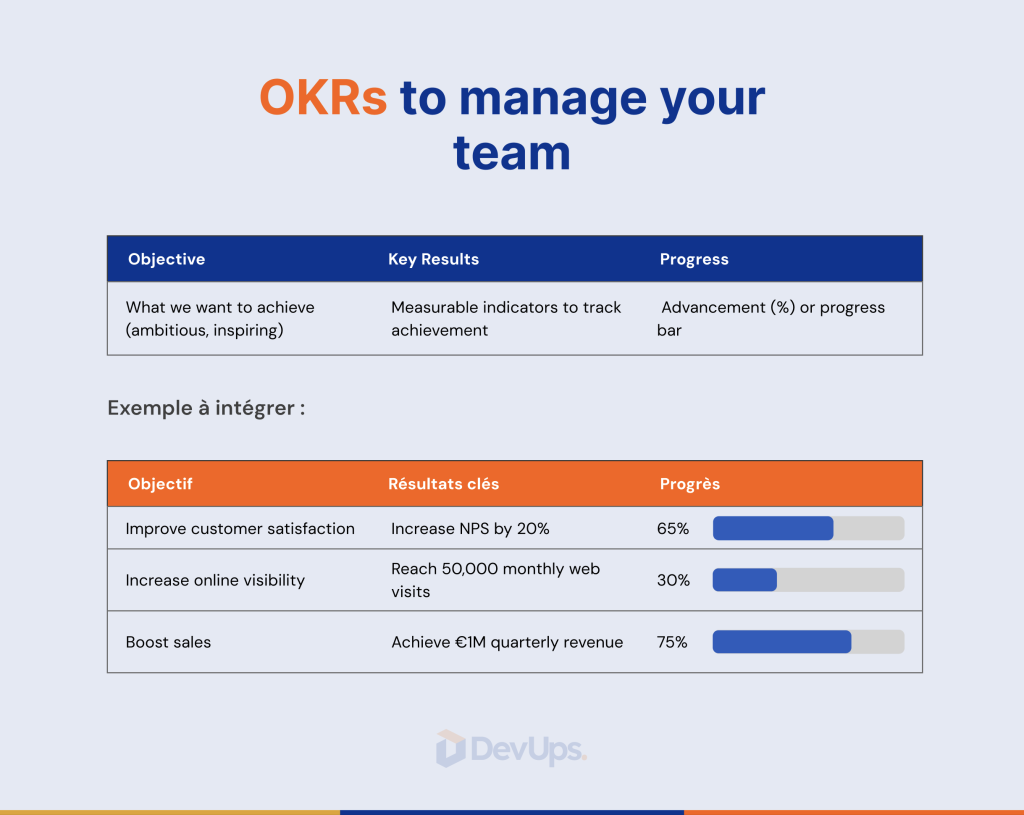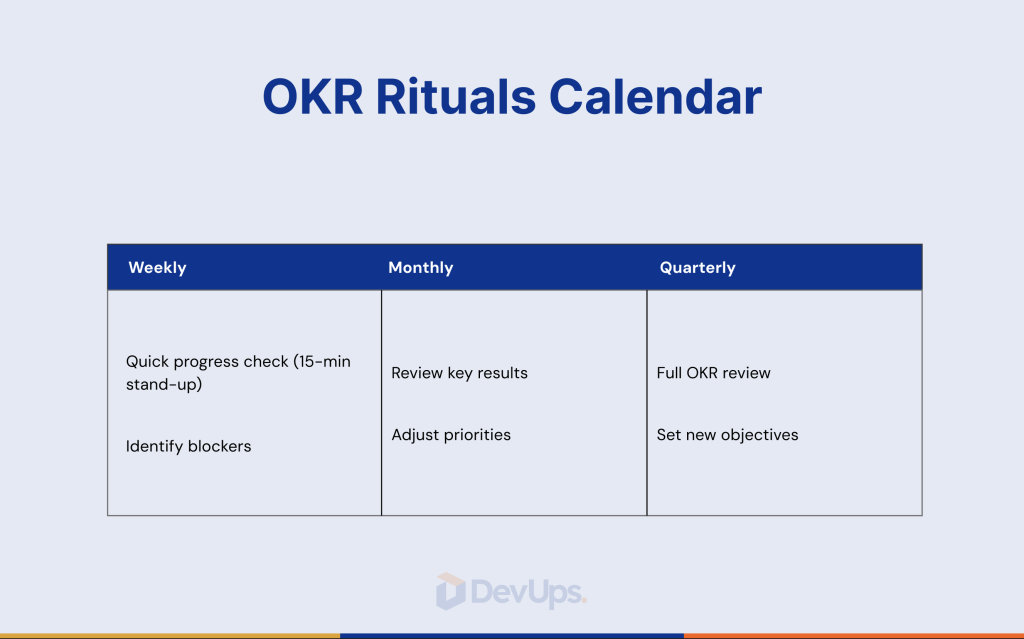OKRs to manage your team: method, examples, free template

OKRs to manage your team means leading by outcomes, not tasks. OKRs (Objectives & Key Results) align everyone on clear goals and measurable results, while giving teams autonomy in how they deliver. In this guide you’ll get a clear definition, a step-by-step method, real-world examples, and a free OKR template to launch this quarter—so you can adopt OKRs to manage your team with confidence.
Need a tailored setup? Talk to our experts DevUps
What are OKRs? A clear definition
OKRs are a goal-setting system used by high-performing companies to focus effort, measure impact, and drive progress.
- Objective (O): qualitative, inspiring, outcome-oriented (e.g., “Accelerate inbound acquisition”).
- Key Results (KRs): 2–4 quantitative results that prove the Objective was achieved (e.g., “Grow from 3,500 to 10,000 monthly visitors”).
Unlike a task plan, OKRs specify what matters and how success is measured, then let teams choose the best initiatives to get there.
👉 Big-picture context for SMEs:
Why digital transformation is critical for SMEs
Why adopt OKRs to manage your team?
Adopting OKRs to manage your team helps you:
- Align strategy with daily work (everyone knows what matters).
- Prioritize and say no to distractions.
- Measure progress objectively, without micro-management.
- Empower teams through clarity and autonomy.
- Learn fast via short cycles (monthly/quarterly).
🎯 Result: more focus, less inertia, and a culture of continuous improvement.
OKRs to manage your team vs. traditional goals
| Dimension | Traditional goals | OKRs |
|---|---|---|
| Formulation | Often tasks | Outcomes to achieve |
| Measurement | Vague/subjective | Quantified and bounded |
| Horizon | Long and fixed | Short (month/quarter) |
| Ownership | Individual | Collective and aligned |
| Steering | Retrospective | Ritualized weekly reviews |
💡 OKRs don’t replace KPI. KPI describe the state; OKRs drive the change.
How to structure effective OKRs to manage your team
A solid OKR has three parts: clear Objective, measurable KRs, and reliable metrics. Use these real-world examples out of the box.
Example 1 — Marketing (SMB B2B)
Objective: Increase qualified organic visibility.
Key Results:
- Grow from 3,500 to 10,000 monthly unique visitors (GA4).
- Earn 3 high-authority backlinks (DR ≥ 60).
- Reach 2,000 qualified LinkedIn followers (≥2.5% engagement).
Example 2 — Sales (inbound)
Objective: Improve conversion on inbound leads.
Key Results:
- Raise close rate from 12% to 20%.
- Cut average sales cycle from 21 to 14 days.
- Publish 8 customer testimonials (site/LinkedIn).
Example 3 — Product (SaaS / customer portal)
Objective: Accelerate adoption of portal v2.
Key Results:
- Lift MAU from 15% to 40%.
- Achieve NPS ≥ 35 on v2.
- Reduce onboarding-related churn from 20% to 10%.
Use the Team_OKRs sheet to duplicate these examples and launch your quarter.

Implement OKRs in 5 steps to manage your team
- Educate: explain “outcomes, not tasks,” share 1–2 internal examples.
- Choose cadence: quarterly for strategy, weekly for reviews.
- Co-write: 1–3 Objectives per team, 2–4 KRs per Objective, clear metrics.
- Review without micro-managing: weekly check-ins (progress %, confidence, status).
- Learn and iterate: end-of-cycle retro, keep what works, adjust the rest.
👉 Automate reminders and updates (Slack/Email/Notion): Automate tasks without code using Zapier
Review rituals: weekly, monthly, quarterly
- Weekly (30 min): update KRs (progress %, confidence 0–10, RAG status), unblock decisions.
- Monthly (60 min): alignment review, reprioritize initiatives.
- Quarterly (2 h): retrospective, insights, new OKRs.
Pro tip: distinguish results (KRs) from initiatives (projects). You adapt the initiatives—not the ambition of the KRs at the first obstacle.

Tools to anchor OKRs in daily work to manage your team
- Notion / ClickUp: OKR pages by team + embedded check-ins.
- Google Sheets + GA4: single sources of truth for metrics.
- Zapier: auto-reminders, CRM/Slack sync, field updates.
👉Useful no-code flow: Automate tasks without code using Zapier
Common mistakes to avoid
- Too many Objectives: stick to 1–3 per team.
- Output KRs instead of outcome KRs: “publish 12 posts” ≠ “+2.5% engagement.”
- Unreliable metrics: define sources and formats.
- No rituals: without reviews, OKRs stay theoretical.
- Changing KRs mid-cycle: adjust initiatives, not the target.
📘 Read next: Marketing automation: why and how to get started
Our OKR method at DevUps
We deploy OKRs to manage your team with a modular approach:
- Strategic framing + co-writing workshop.
- OKR template setup (Notion/ClickUp/Excel) connected to your data.
- Automated rituals (Slack/Email) and dashboards.
- 4–12 weeks of coaching to embed routines.
👉 Explore strategy & operations support: DevUps services
Conclusion
Choosing OKRs to manage your team means choosing clarity, accountability, and steady progress. Start with one Objective per team, measurable KRs, and regular reviews. The rest—discipline, alignment, results—follows naturally.
📩 Want a coach to deploy the method and keep it running?
👉 Contact DevUps—we’ll set up the system so you can focus on outcomes.
Latest Insights and Tips
Start building your digital ecosystem today. Get in touch with our team to discuss your project.







